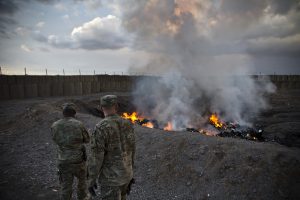
“Every day I wonder, ‘Is today the day that toxic exposure catches up with me?’” Navy veteran James L. Price said as he closed out his testimony before the House Veterans’ Affairs Committee in May.
Lauren Price, Jim’s late wife, was a dedicated sailor and advocate for “her all,” as she so graciously referred to her brothers and sisters in arms. At the age of 56, Lauren lost her life to cancer in March 2021, just 44 days after she was diagnosed. I was honored to invite Jim to speak about Lauren and about his own veteran experience. I will carry the Price family in my heart for the rest of my life, but the fact is that stories like theirs are all too common.
Hundreds of thousands of veterans who, like Lauren, are otherwise healthy and in the prime of their lives are suffering from uncommon cancers: leukemia, Parkinson’s disease, vision loss, and more, following their time in uniform. They believe those diagnoses are a result of exposure to dangerous chemicals from open-air burns pits, particulate matter, per- and polyfluoroalkyl substances (PFAS), or other toxins while serving. However, because it can take years, if ever, for science to conclusively prove that a diagnosis or disability is caused by an exposure, these veterans often can’t get the support they need from VA. In some cases, that proof is impossible to attain due to the nature of the exposure or how long it has been since it occurred. That is what prevented some Vietnam-era veterans from receiving benefits for Agent Orange exposure until decades after their service. Congress finally delivered benefits to Blue Water Navy Vietnam veterans in 2019, 44 years after the Vietnam War ended. We cannot let the same travesty wreak havoc on veterans of Iraq and Afghanistan. Yet VA estimates that half of all claims for compensation related to burn pit exposure are denied.
I don’t want any servicemember or veteran – particularly not one who is sick – to have to fight for the benefits they have earned or wait decades for science to catch up to their reality.
Toxic exposure hits close to home for me, not just as the Republican leader on the House Veterans’ Affairs Committee and a veteran myself, but also as the father and grandfather of two active-duty Marines. I don’t want any servicemember or veteran – particularly not one who is sick – to have to fight for the benefits they have earned or wait decades for science to catch up to their reality. That’s why, two days before Lauren’s passing, I introduced the bipartisan, bicameral Toxic Exposures in the American Military (TEAM) Act.

The TEAM Act would make it easier for toxic-exposed veterans to enroll in the VA health care system and file for VA benefits. It would also improve training for VA staff in how to identify and treat toxic exposure and, perhaps most importantly, require further research into toxic exposure to ensure that science keeps pace with the needs of toxic-exposed servicemembers and veterans. The TEAM Act would do right by these men and women today and tomorrow by delivering the services they need now and ensuring that future decisions regarding their care and benefits are made by scientists, not politicians.
Policymakers from both sides of the aisle and the Administration must get together to find a bipartisan, fiscally-responsible, and scientifically-sound solution.
Many aspects of the TEAM Act are included in the toxic exposure omnibus bills advanced by the Senate Committee on Veterans’ Affairs in May and, along a party-line vote, by the House Committee on Veterans’ Affairs in June. But it’s now Veterans Day and we are no closer to delivering the support that toxic-exposed veterans need than we were when Jim testified before Memorial Day. That is a shame on the Democrat-controlled Congress and the Biden Administration, who are apparently more focused on their trillion-dollar spending sprees than on caring for the men and women who safeguarded our democracy in the first place.
Enacting meaningful legislation for toxic-exposed veterans will be costly and complicated. Preliminary estimates from VA indicate that it could cost several hundred billion dollars to extend health care and compensation benefits to toxic-exposed veterans. Those costs could be driven even higher if Congressional Democrats succeed in staying well ahead of science by establishing a laundry list of diagnoses that would be eligible for automatic compensation, absent any evidence to attempt to tie them to toxic exposure. That’s why policymakers from both sides of the aisle and the Administration must get together to find a bipartisan, fiscally-responsible, and scientifically-sound solution that can be paid for and that can pass the House and the Senate and be signed into law. I have been calling on my Democratic colleagues to do that for months. The time for action is now, in honor of toxic-exposed veterans like Jim, like Lauren, and the thousands more that are leaving us far too soon every day.
Mike Bost represents the 12th district of Illinois in the U.S. House of Representatives where he serves as the Ranking Member on the Committee on Veterans’ Affairs. Congressman Bost served in the U.S. Marine Corps from 1979 to 1982 where he was trained as an electronic specialist and radar repairman.




